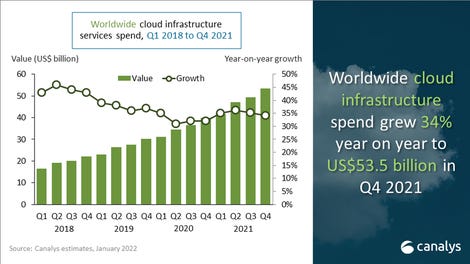Companies around the world spent $53.5 billion on cloud infrastructure in the fourth quarter of 2021, bringing full-year spending to $191.7 billion, nearly $50 billion more than in 2020.
As usual, the big three dominated cloud infrastructure spending, accounting for 61% of the $53.5 billion in the fourth quarter of 2021, according to analyst Canalys. Amazon Web Services got a 33% market share, followed by Microsoft Azure’s 22% and Google Cloud’s 9%. Other cloud providers took 36% market share.
Growth also followed the usual order: although still a loss-making part of Alphabet, Google Cloud’s revenue grew the fastest at 63% year-over-year. other, followed by 46% for Azure and 40% for AWS. In a sign of industry maturity, year-over-year growth in cloud infrastructure spending has slowed from 2018 levels of around 50% to 34% this quarter.
Rising revenues for cloud giants
This Canalys analysis follows Amazon’s fourth quarter 2021 earnings release. Although Amazon fell short of analysts’ estimates, its AWS subsidiary’s revenue rose 40% year-on-year to $17.78 billion, helping it post revenue of $71 billion.
Alphabet reported this week that Google Cloud’s fourth-quarter 2021 revenue grew 45% year-on-year, but it’s still struggling to reduce its quarterly operating losses that have historically topped $1 billion. This quarter the loss was $890 million, down from the huge loss of $1.24 billion in Q4 2020.
Last month, Microsoft boasted that growth in the “number of larger, longer-term Azure contracts” fueled its cloud growth of 46% in fiscal Q2 2022.
The metaverse invites itself
Canalys sees the metaverse and related augmented and virtual reality technologies driving cloud service spending and infrastructure deployment over the next decade.
While the metaverse is still being defined, Canalys sees use cases for the nascent virtual world in gaming, social media, workplace collaboration, education, real estate, e-commerce . Whatever happens is good news for cloud providers.
“Computation will be in high demand in virtual and augmented reality environments, while storage, machine learning, internet of things and data analytics will be essential to support operations such as digital pairing, modeling and interactivity in the metaverse,” adds Blake Murray, research analyst at Canalys.

Canalys.
Source: ZDNet.com
